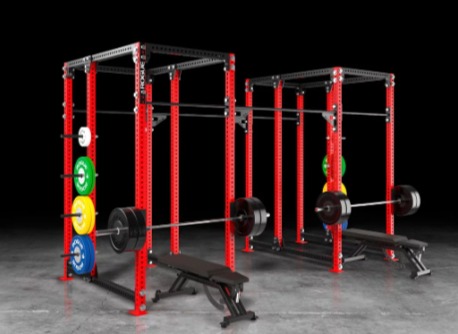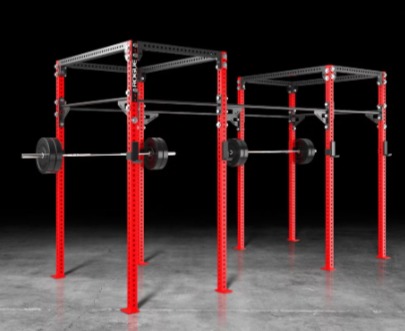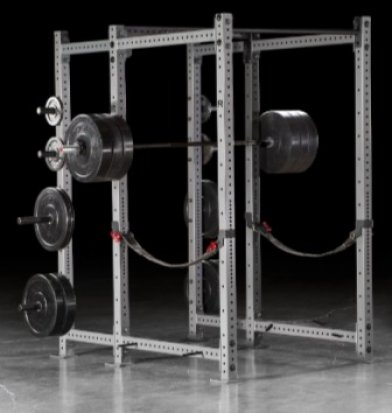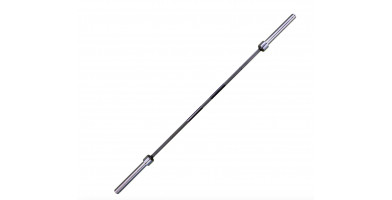Rogue Rig 2.0 Fully Reviewed & Compared
The Rogue Monster Rig 2.0 is one of the most rigid, full featured, heavy duty squat racks in the entire Rogue catalog. From the 3 by 3 inch steel framing on the uprights, to the oversized one inch assembly bolts, this rack will go the distance and stand up to constant use at any commercial or garage gym.
The rack is meant to be customized, and Rogue even added laser cut holes on the sides of the uprights. Those extra keyholes, and the numbered positions for pins and J-Cups, allow you to add any item in the Monster accessory line to the base rack. You have options for plate, band, and chain storage, additional rack space, several kinds of pull up bars, and so much more.
Let’s take a closer look at the features and attachment options that this massive multiple use rack has to offer. We call it multiple use because the addition of extra racks in different lengths can give you up to 24 feet of total length. This allows several users to work out at once.
Almost endless options for upgrades and add-ons
Rigs have been enhanced based on user feedback
Rogue units known for sturdiness, stability
Comes in a choice of 11 finish colors
New upgrades for Monster come out first (before Monster Lite)
Expensive, with large footprint
Multiple users will be close together, without as much privacy
A Word About Rigs
A rack, in lifting parlance, is a four-cornered steel frame that provides a stable resting place for loaded Olympic barbells. A rack will facilitate changing working weights quickly, with no need to set the barbell on the floor or use a deadlift jack. Racks typically have safety features, like squat spotter arms or pin and pipe safeties, to stop dropped barbells in their tracks.
Even the most low-end racks will feature steel uprights with holes in them, for the barbell resting hooks to snap in place. This means you can do a variety of exercises, with a starting and ending point as low or high as you desire. Racks are the cornerstones of most gyms because they make squats and other potentially heavy lifts possible. Try to imagine getting a barbell onto your shoulders from a regular bench or from the floor, and you will understand why racks and power racks are so important to the sport.
What a rig does is join several racks together, often with steel bars that can be further used as pull up bars. 2 or more racks joined together mean more squatting and benching stations for multiple users, too.
A typical rack found in a home gym will only have space for one weight bench.
But a rig accommodates multiple users at once, with each performing their own goals safely, with minimal interference from other users and no need to wait in line. And thanks To Rogue’s business model, a gym or CrossFit box owner can get all their rigs, benches, barbells, and desired accessories from the same time, at cost savings and with a single point of contact for technical issues.
If you want to find out more about the other products from this manufacturer, read our Rogue Monster Wall Mount Rig review.
Points of Difference
For one thing, you can order the Monster 2.0 in three different configurations, which Rogue calls Editions, right from the product page. This means the rig is customizable by length. Each Edition will offer more or fewer stations for users to work out, depending on length.
The Base 2.0 Edition is available in lengths of 12, 14, 20, and 24 feet. Sections are either 4 or 6 feet, with each section functioning as a standalone rack. Uprights, the square rods that J-Cups and accessories attach to, are 108 inches or about 9 feet. The height means the rack is accessible to any user but also makes the rig unsuitable for home gyms which often have 8-foot drywall or drop ceilings.
The Base 2.0 Edition only comes in a black finish, with bright zinc mounting hardware. There are other colors available for the Standard and Racked Monster 2.0 editions. A 10 foot Base 2.0, made of a 6-foot section connected to a 4 foot one, will give you 2 squat and bench press slots, as well as 5 pull-up bars and a total of 6 pull up stations. The 24 foot Base, which Rogue calls the M-24, is enough for a hole CrossFit class with 6 squat/bench spots and 14 pull up stations.
The longer your initial rig, the more J-Cups you get as part of your order. The M-24 includes six pairs, with each pair able to hold an Olympic barbell n place for loading and unloading with weight plates.
The Standard Monster 2.0 rig adds 11 color choices, enough to match the look and feel of any gym or sports team. It features the same 3 by 3-inch uprights with laser cut holes and adds 3 by 3-inch beams at the top of each section. The extra beams add stability, creating peace of mind for heavier lifts.
The 10 foot Standard will have 5 pull up bars, and the 24 foot one will have 10 pull up bars; each configuration has extra pull-up stations thanks to the center freestanding bars that connect each section. This means the Standard M-24 has 16 pull up stations, with room 6 users to do bench and squat lifts at the same time.
Finally, the Racked 2.0, which retails at over $4,000 USD, comes in the same 10, 14, 20, and 24-foot lengths of bolted together racks. A drop-in or adjustable bar gives you different working depths for a range of movement and safety, without changing the footprint of the rig once the sections are in place.
Pull up bars on both the Standard and Racked options will be 70 inches long, with what Rogue calls a pass-through gusset for customizable grip height and for more stability. The gussets offer different start positions on the same pull-up frame. To cut down on confusion and make operation even smoother, the Racked 2.0 Edition has numbered J-Cup holes on the uprights (all four sides) as well as on the bottom cross-members. Those extra holes and reference numbers mean the Racked will be almost unlimited when it comes to add-ons--which we will talk about next.
Partial Upgrades List
Safety spotter arms sit at ground level, in the lowermost upright holes, and look like jack stands you’d find at a mechanic shop. These angled ramp-like pieces of steel will catch a squat barbell of the person doing the squat loses control and drops the bar. Safety spotter arms prevent injury and damage while letting you lift heavy with peace of mind. You can focus on the form and on cranking out perfect reps, rather than worrying about what will happen if you can’t complete one of those reps.
The Matador Dip Station is a steel frame that attaches to the uprights to let you do bodyweight or weighted dips to work your chest, arms, and back. You can attach the Matador at any height, and take it right back off with no tools when you are ready. If you want to do the chain, band, or belted/plated dips, the Monster Rig 2.0 offers storage for all those resistance tools.
The Monster Landmine is a long bar with a hinge on one end and a plate mounting collar on the other. The hinge lets you lift the single plate from almost any starting position outside the rack, making it possible for you to do rows and other barbell lifts while attacking new muscle groups, finding a more full range of motion, and avoiding fatigue from using a standard barbell every single time.
Durability
Safety Features
Pin and pipe safeties consist of a thick steel pipe that snaps between the uprights with a quick release pin on each end.
Flip up safeties are like smaller versions of uprights, which sit horizontally between the actual uprights and also snap in place, with no tools or nuts and bolts needed.
Nylon strap safeties are thick pieces of machine-stitched nylon that both catch loaded barbells and roll them away from the direction of the user in case of droppage.
The Final Word
If you are a dedicated lifter, with some time and progress under your belt, and you are ready to deal with the time, expense, and amount of space needed for even the Base model, we say go for it. The Monster Rig also appeals to group fitness facilities because of how it lets multiple users work out without waiting in line and with the ability to rotate from lifting to pull ups. For those who want, need, and can accommodate it, the Rogue Monster Rig 2.0 is a piece of gigh capacity precision equipment that will last virtually forever, backed by Rogues top-rated customer service and warranty departments.














